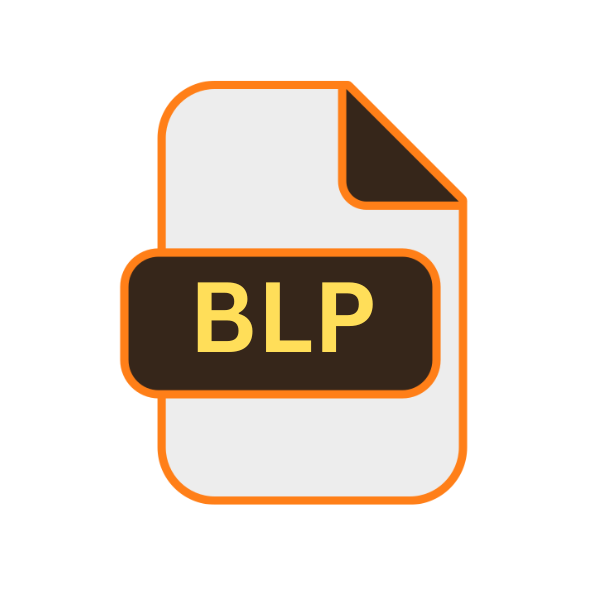.BLP File Extension

Blizzard Texture File
| Developer | Blizzard Entertainment |
| Popularity | |
| Category | Game Files |
| Format | .BLP |
| Cross Platform | Update Soon |
What is an BLP file?
The .BLP file extension is associated with Blizzard Entertainment, a prominent game developer known for popular titles like World of Warcraft, StarCraft, and Diablo. BLP files are texture files that store graphical data, primarily for game assets, including character models, environment textures, and UI elements.
These files play a crucial role in rendering the visual elements that contribute to the immersive experience of Blizzard’s games.
More Information.
The .BLP file format was introduced in the late 1990s with the release of early Blizzard games. The initial purpose was to create a format that could store various types of texture data, including compressed and uncompressed images while supporting multiple levels of detail.
This was essential for the scalability of game graphics, allowing the same texture to be used across different hardware configurations and graphical settings.
Origin Of This File.
The .BLP file format was developed by Blizzard Entertainment to efficiently manage texture files within their game engines. The need for a proprietary texture format arose from the requirements of their game engines to handle high-quality graphics while maintaining performance.
The BLP format was designed to optimize the storage and retrieval of texture data, enabling quick loading times and smooth gameplay.
File Structure Technical Specification.
The .BLP file format consists of a header followed by image data. The header contains metadata about the texture, including the format version, dimensions, mipmap count, and compression type. There are two main versions of BLP files: BLP0 and BLP2.
- BLP0: This version supports only uncompressed or JPEG-compressed images.
- BLP2: This version supports both uncompressed and DXT (DirectX Texture Compression) formats, which are more efficient for modern graphics processing.
Header Structure
The BLP header typically includes the following fields:
- Signature: Identifies the file as a BLP texture.
- Version: Specifies the format version (0 or 2).
- Compression Type: Indicates the type of compression used (e.g., JPEG, DXT).
- Width and Height: Dimensions of the texture.
- Mipmap Count: Number of mipmaps included in the file.
- Offset and Size: Specifies the location and size of each mipmap level.
How to Convert the File?
Converting .BLP files to more commonly used formats involves using specialized tools or software. Several utilities and scripts are available that can read and convert BLP files, such as:
- BLPConverter: A standalone tool that can convert BLP files to formats like PNG, JPEG, and TGA.
- ImageMagick: A command-line tool that supports various image formats, including BLP, through additional plugins.
- WoW Model Viewer: A tool used by the World of Warcraft modding community that can export textures from BLP to other formats.
Advantages And Disadvantages.
Advantage:
- Efficient Storage: The BLP format supports various compression methods, reducing the file size and optimizing storage.
- Performance Optimization: Mipmaps improve rendering performance by providing pre-calculated levels of detail.
- Proprietary Format: Tailored specifically for Blizzard’s game engines, ensuring compatibility and optimal performance.
Disadvantage:
- Limited Use: Being a proprietary format, BLP files are not widely supported outside of Blizzard games.
- Conversion Requirement: To use BLP textures in other applications, conversion to more common formats like PNG or JPEG is necessary.
- Complexity: Understanding and manipulating BLP files requires knowledge of their specific structure and compression methods.
How to Open BLP?
Open In Windows
To open BLP files on Windows, you can use several software options:
- BLPViewer: A dedicated viewer for BLP files, allowing you to preview and convert them. This tool is specifically designed for handling BLP files and provides an easy-to-use interface for managing them.
- GIMP with BLP Plugin: The GNU Image Manipulation Program (GIMP) can open BLP files with the appropriate plugin installed. This free and open-source image editor is highly versatile and, with the BLP plugin, can handle Blizzard texture files effectively.
- IrfanView: A popular image viewer that supports BLP files with the necessary plugins. IrfanView is lightweight and supports a wide range of file formats, making it a convenient choice for viewing and converting BLP files.
Open In Linux
Linux users can also open and manipulate BLP files using tools like:
- GIMP with BLP Plugin: Just as on Windows, GIMP on Linux can open BLP files with the correct plugin. GIMP is available for Linux and can be extended with plugins to handle various file formats, including BLP.
- ImageMagick: A versatile command-line tool available on Linux that can handle BLP files with additional support. ImageMagick is powerful for batch processing and converting images, including BLP textures.
Open In MAC
Mac users can access BLP files through similar methods:
- GIMP with BLP Plugin: GIMP on macOS can be extended with a BLP plugin to open and edit these files. This cross-platform image editor provides the same functionality on macOS as it does on Windows and Linux.
- BLPConverter: Available for macOS, this tool can convert BLP files to other formats. BLPConverter is straightforward and user-friendly, allowing for quick conversion of BLP files to more common formats like PNG or JPEG.
Open In Android
Opening BLP files on Android devices requires a more indirect approach, typically involving conversion to a more common format:
- Convert to PNG or JPEG: Use a desktop tool to convert BLP files to PNG or JPEG, then transfer them to your Android device for viewing. There are several apps and online tools available for this purpose.
- Remote Desktop Applications: Use remote desktop apps like TeamViewer or Chrome Remote Desktop to access a computer that can open BLP files and view them on your Android device.
Open In IOS
Similar to Android, iOS devices require BLP files to be converted to a compatible format:
- Convert to PNG or JPEG: Convert the files on a desktop computer and transfer them to your iOS device for viewing. Apps like iCloud Drive, Dropbox, or Google Drive can facilitate the transfer and viewing of these images on your iOS device.
- Remote Desktop Applications: Use remote desktop apps like TeamViewer or Chrome Remote Desktop to access a computer that can open BLP files and view them on your iOS device.
Open in Others
For other platforms, the general approach involves converting BLP files to more universally supported formats. This ensures compatibility across various devices and software environments.
Tools like ImageMagick and GIMP with the appropriate plugins can be used on various operating systems to convert BLP files to formats like PNG or JPEG, which are widely supported.













